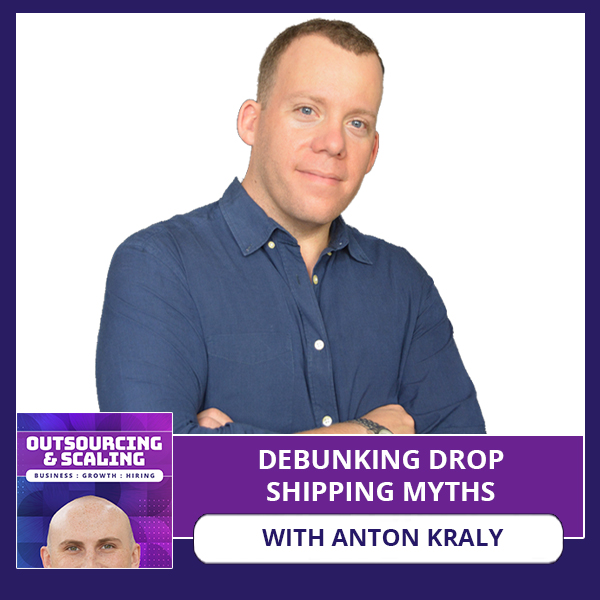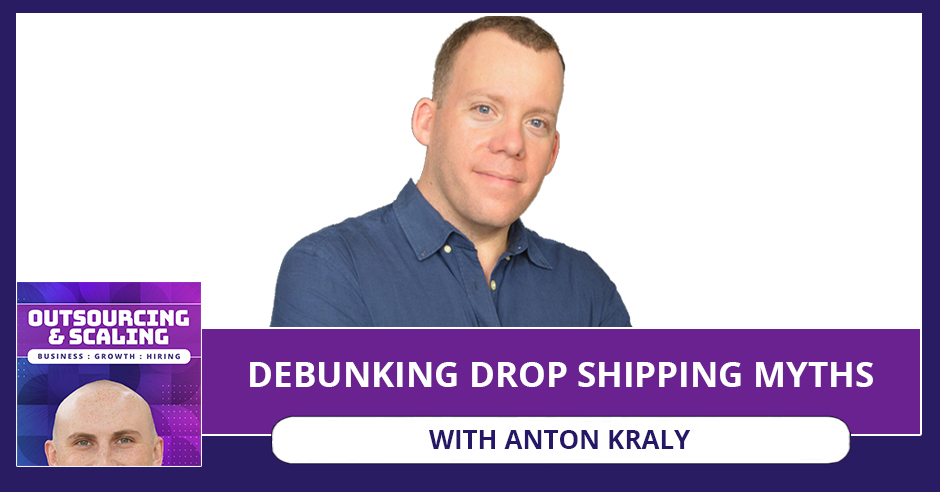


If you know anything about drop shipping, it’s that it is a broad term and involves a complicated process. On today’s show, Nathan Hirsch interviews Anton Kraly, the Founder of Drop Ship Lifestyle, to answer some of the most crucial questions and debunk some myths about drop shipping. Being a serial entrepreneur for more than a decade and finding success building and selling multiple seven-figure businesses, Anton is still strong in the entrepreneurial space despite the huge competition. Don’t miss this episode to discover Anton’s strategies for staying strong in the game.
—
Listen to the podcast here:
[smart_track_player url=”https://www.podetize.com/statsapi/www.podetize.com/wp-content/uploads/fileuploads/11-5b145ef137b51b3d1af0633e9305c43d/03/2020/d77dcab50438fafe729194baef23105c.mp3″ title=”Debunking Drop Shipping Myths With Anton Kraly” artist=”Nathan Hirsch” image=”https://freeup.net/wp-content/uploads/2019/04/OAS.png” ]
Download the audio file here.
Debunking Drop Shipping Myths With Anton Kraly
My guest is Anton Kraly. Anton, how are you doing?
I’m doing well, Nathan. Thanks for having me on.
I’m pumped to talk to you. We were talking before I got into dropshipping back in 2008 and sold over $25 million doing it. I know you’re all into teaching people how to drop ship more high-ticket items, which is not what I was doing, so I’m interested in talking about that. For those of you that don’t know him, he’s a serial entrepreneur for more than a decade, finding success building and selling multiple seven-figure businesses. In 2013, he started Drop Ship Lifestyle to teach people how to create a profitable eCommerce business by leveraging high ticket dropshipping. Voted best eCommerce course by Shopify in 2018, Drop Ship Lifestyle is now the top online eCommerce coaching program and has helped over 10,000 students in 25 countries to find freedom through entrepreneurship. We’re going to talk all about that, but first, let’s take a gigantic step back. What were you growing up as a kid? Were you a straight-A student? Were you a rebel? Did you always know you wanted to be an entrepreneur?
I’ll take number three. I always knew I wanted to be an entrepreneur. I was not a straight-A student, but also not much of a rebel, just a normal guy. I played some sports, played a lot of video games, had a good time, but not school smart. I didn’t have that strength or at least wasn’t interested enough to be.
Did you go to college?
I did. I’m from New York on Long Island and I went upstate at SUNY Albany. I did that because it was a state school. It was relatively cheap. It was a big school and I didn’t want to miss out on that experience. Growing up, watching all the movies, I’m like, “I want this,” the party side of it. I did do better in school. I studied marketing and management. I don’t think I learned anything that applies to what I do now, but I did perform better there. It was something I was interested in.
Did you get a job after college? Did you go right into being an entrepreneur?
I went right into it. Throughout high school and even breaks from school, I worked with this guy in the same town I grew up in that had all these different businesses, like a landscaping business. He had a home repair business, he flipped houses. I started selling Christmas trees for this guy when I was fifteen years old and I kept doing different things with him. That was my income. Right when I got out of school, I was dead set on the day I graduate is the day I could start a business. Looking back, I could’ve started a lot sooner, but as soon as I graduated, I was looking for businesses to buy and I ended up buying my first business shortly after.
Can you tell us more about that business and what that experience was like?
It was bad. What I did back then, a lot of lessons learned. That’s what comes with time. I basically bought the cheapest business I could find. Don’t do that. Before I did that, I was looking into all these franchise opportunities and I was super close to signing a loan with the SBA for $250,000 to open a Pita Pit. It’s like Subway but in pitas. That guy was ready. We had the space picked out. I had the whole team came in from them and met with me and then last minute, I was like, “I don’t want to be in here 80 hours a week.” My goal was to build it up, build more, sell them, and get into another business. I didn’t know about online business but I backed out of that the last minute. I bought the cheapest business I could find, which was a delivery route for a bakery in Brooklyn. I would go into Brooklyn at 4:00 AM or 5:00 AM, load up this truck that I bought and drive to Long Island. Basically, sell bread and cookies and stuff to stores on Long Island.
Were you doing it yourself? Did you eventually hire people to help you?
I did it myself. It’s funny we got started literally right around the same time with the eCommerce. I graduated in 2006, so I bought that probably early 2007 and I was doing it. I was trying to figure out what do I want to do? My original plan was to build it up, flip it, buy another business, repeat. Basically, what happened is I hated it but I couldn’t do anything else because all my money was in it. The book The 4-Hour Workweek came out. I read that it talked about the chapter on Yahoo stores and a chapter on AdWords. I was like, “I have cookies. I have time.” I made a website called New York Cookie Shop. I started selling those cookies and I ran AdWords and it started making more money than that offline business. That’s when I was like, “eCommerce, that’s mine.” I built and built and sold cookies for maybe six months to a year because I started to experiment with more and more expensive products. I figured if I’m selling $20 boxes of cookies, why can’t I sell a $1,000 chair? I worked my way up.
What were you selling on Amazon or Shopify? Was it a lot of channels or just one?
Not on Amazon. When they were still available for external sites, we used Amazon product ads. At first, I had the Yahoo store and then had an eBay account. What I was trying to do back then was basically have it so people would find the eBay listings and then be incentivized to go to the website. Most of the revenue came through the store itself.
Talk about the pros and cons of dropshipping. I’m sure a lot of people that have followed me have heard me talk about it, but I’d love to hear from you.

It’s different. I definitely can, but it’s difficult because dropshipping is a broad term. It means one thing, but people use it in many different ways. All it is having somebody else fulfill your orders. You could do that in a lot of different ways. The way that we do it and I’ve done different ways, the best is by working with domestic brands. For us, that’s brands that are in the States. We’re not private labeling products for the most part. What we’re doing is selling products that they already make, that they already sell, that they already have in warehouses locally and we’re simply a way for them to get sales. We’re an online retailer for those brands. I mentioned there are other ways to do it. Some people drop ship off eBay or Amazon or vice versa and they do these low-ticket products. Some people drop ship from China. That I have done as well. I experimented with it and what happened is I got a lot of sales and I had a lot of unhappy customers. I realized quickly this is not what we’re going to do for long.
Long shipping times and I agree. I did the domestic thing for a while. I was doing more low margins. I also got in at a time where you could do that. The competition wasn’t crazy as it is now, which makes it tough to do. When you say high-ticket, do you define that anyway?
Typically, what I’m looking for are products that are at least $200. That’s what I tell people to get their mind working in the right direction. With our store, the average order value is usually $1,000-plus.
What type of products are they?
If anybody goes to Wayfair.com and it’s a $1 billion site publicly traded and go through any of their top-level categories, mostly things like that. Different home goods categories and we build them as niche-specific stores and then any hobbies that fall into that price range.
One of the reasons I avoided high-ticket items was the whole returns. That was a nightmare. If someone wants to return a $25 product, no big deal, I can refund them if I ship it back. It’s cheap. What is your mindset when it comes to returns on high-ticket items?
For me, it got easier when I switched to dropshipping. I started with that cookie website. I’m thinking, “This is working. What can I sell that’s more expensive?” Back then, I started checking eBay completed listings and things that sold consistently at high prices. I didn’t know about dropshipping. I found Alibaba.com and I started to bring in containers of all different types of things. Not a huge spread of products, but maybe ten different products because it’s much money when you’re bringing in all this stuff.
Back then I was using fulfillment centers around the country. I was selling things. If a customer wanted to return it, I was screwed because it went back. I had to pay for them to unpack it to see if it was resalable to sometimes throw it out. For me that was what I was used to and it was built into the margin, so I was okay with it. When companies started reaching out to me and saying, “Do you want to sell our stuff?” A lot of them said, “If the customer wants to return it, it comes back to us.” For me, that was an upside. It was beneficial. It was better than what I was doing before that.
Let’s talk about hiring. One thing that I experienced at dropshipping is that there was much going on from tracking numbers. Now there’s more software and stuff than there was back then, but tracking numbers, customer service, what do you hire for in an eCommerce business and a dropshipping business?
It’s traffic. I don’t like outsourcing that, especially if your plan is to grow and scale. Most people should have control over it and understand it because once everything else is set. That’s how the business is going to grow. That’s how you can 10x it or 20x it. It’s by putting a lot more money in. I personally don’t like saying, “A person that has a good online presence, here’s $300,000. Let’s see what happens.” We don’t outsource traffic. We do outsource creativity, so a lot of times different ads. We don’t have a great video editor or anything in-house, so we do that. The biggest thing for someone starting out or someone that’s growing crazy is having around the clock, somebody on live chat, somebody to answer the phone. Especially with what we do and what our students do, we’re not bringing in 1,000 orders a day. A lot of stores get three sales a day or two sales a day and sometimes that sale might be worth $8,000 and sometimes that person sends in a live chat at 7:00 PM and says, “I want to check if you have this in stock.” Missing that could mean thousands and thousands of dollars of net profit. That’s the first thing. It’s not the most expensive thing to have and it’s the biggest return, in my opinion, I will get on a contractor or a VA.
Can you walk us through the structure of one of your businesses? Do you have team leaders, managers? How many people is it? What are they doing?
It’s different. When I first started, it was me and then a virtual assistant. Where we are now, there are team leaders and our team is mixed. We’re virtual but we have about half our team in the States and there was one person on our team in the States, that’s the business manager and he oversees one person that’s on our team. All of our VAs are in the Philippines. He oversees all of them, but one person mainly and he’s the team lead there. It works well for the way things are going now because it’s one point of communication and everything revolves around that. In the beginning, it was me on Skype back then talking to somebody saying, “Is this happening?”
Is there any first hire you recommend? Is the first hire that 24/7 person or that team of people that are covering? Are there any other first hires that you would recommend?
I’d recommend that person and then for most people when they’re getting started at least. They’re doing everything themselves. Not having them work your same hours, having it either be overlapping or maybe having it be when the busiest time is where you’re not available. Maybe you’re still working full-time and your phone is ringing and you are seeing live chats come through on your phone and you can’t answer it. It’s having somebody because that could make or break your ability to be able to be profitable enough to go full-time into this. What’s good is a lot of these things aren’t things like the phone calls, the live chats.
We don’t get tons of orders so the sites aren’t blowing up all day like, “How can I respond to all these people?” Having the person that can do that, but then also having them in charge of making sure that orders are tracked. One thing I would recommend for this, a lot of people when they hire and they say, “I want you to make sure all of our orders are sent to the suppliers. Make sure they’re not forgotten about. Make sure our customers have tracking. Make sure emails are responded to,” but they don’t have a system to track that. The person might be on Slack and signed in, they’re thinking it’s all happening. They’re thinking it’s all working well. What we started doing is putting all of the work into one place so we don’t have to ask.

We don’t even have to say anything. Maybe you could see it. For example, a workflow with Shopify orders is we have every new order go to a Trello board and the Trello board puts them into the newest column. When that order gets submitted to a supplier, it moves over. When the supplier says it’s in stock and it ships, it’s moved over. When it’s delivered, it’s moved over again. A lot of the team is doing that. We have automation for where we can, but a lot of it is from an actual person and we can make sure nothing is missed. We can make sure what’s supposed to be getting done is getting done and so can they. Having systems that are visual helped us.
We did the same thing. We use Google Docs and it was every single step gets moved over. It’s similar to customer service emails. It comes in, we’re working on it, we’re in contact with the supplier. It’s resolved. I’m keeping track of every little thing. Are there any hiring horror stories that stand out? Any mistakes that you’ve made that our audience could learn?
I would assume most people do this. I know personally, I’m not a good manager. What I’ve done in the past, especially when we were smaller and I was overseeing everything, is I would bring people on and I would give them our SOP. We do document everything crazy, which everybody should do so they can jump into it. Maybe for a few days I’d make sure they were doing what they were supposed to be doing. I would be like, “The work is getting done. Everything is good.” Sometimes the work would start getting done less or not as correct. It’s my responsibility to oversee it. It was back then and I wasn’t doing it enough and that’s on me. What’s even worse than that is when you have good people come in and they are performing what you ask them to perform, but they’re not growing because you’re disconnected.
A big mistake that I’ve made and I think other people make as well is not interacting. Maybe it’s a weekly call you have with your team, even if your team is one person, where you’re sharing something with them, maybe something you learned online or something you want to try. You’re getting direct feedback from them. You’re putting incentives in place after a couple of months and they’re showing they’re doing well, where you say, “We’re doing this. We think we could do that.” You say, “If we reached this goal, you get X,” whatever it is. I did not do a lot of that in the beginning at all. Once we started putting those things in place, the team didn’t perform where they were supposed to do. They grew themselves and the business. That helped.
One of the things I hear a lot is dropshipping is dead. How do you respond to people like that?
It’s such a high-level thing. I’m sure there are plenty of dropshipping things that are dead. Even when I was doing the dropshipping from China, it lasted a few months as an experiment. To me, that was dead almost on arrival because it was more of a headache than it was worth in terms of profit. Maybe that’s dead. I’m sure people are still making a ton of money with it, but to me that’s dead. The whole thing where people were trying to find stuff cheap on eBay and then make a listing on Amazon or find it cheap on Amazon or on eBay or Craigslist. If you want to make a few bucks, maybe you could do that, but I think that’s not going to be making anybody rich anytime soon. You could say that’s dead with what we do. We are not selling random things. The way we build stores is we build them around niches. We pick what we want to sell. Let’s say it’s stand-up desks. We would build a stand-up desk store, we would get approved to be authorized retailers with the best brands we could find.
It’s not finding a bunch of products and saying, “I hope this sells,” but we would try to find the brands that have the authority that has people searching for them. We wouldn’t throw them on our site, put up a Facebook ad and see what happens. We would build out a product page that was a sales page on Shopify. We would include free bonus gifts if we could. We would have experts support on stand-up desks so people could ask us anything. We would have content for how people could choose one. We would have comparison guides. The thing that’s dead is when you click a button and hope it makes a bunch of money. Maybe that was possible, but we put a lot of effort into our websites, to our stores, to our customer service, to our product pages, to our supply relationships. Because it takes real work, it’s not dead because most people won’t do anything. That’s the way things work.
Are there any eCommerce myths that you can debunk or anything that you see the gurus teaching out there that you’re like, “I wish I could tell people that’s not correct.”
I don’t want to say it’s not correct, but I think it’s the wrong way of doing things, which is selling inexpensive products. It depends on what you want because everybody wants something different out of business and everybody has different goals with what they’re selling. If your goal is to build a business that has a high return on investment that allows you and your team to do less work and earn more money, then the expensive products that come from reliable brands that are shipped fast, that’s the solution. Because what you see from 99% of people that are talking about this stuff is put Oberlo on your website, drop ship from China, and sell the next $15 product. They’ll show a screenshot of one day where they did $20,000, $30,000 in sales, which is great, but you’ll see they have 2,000 orders. For anybody that’s ever done customer service, 2,000 customers in a day, you’re going to go crazy and you’re going to need a big team and that’s the reality. Not that you can’t make money with it, but there are a lot of easier ways. I would say the myth is that that’s the way to success.
I would have to agree with you there. You have over 10,000 students in lots of different countries. What would you say is the difference between the people that have the most success with your program versus people that have less success or for whatever reason fail?
Resourcefulness would be the right word. I try to give people everything that I can, everything that we do. We have amazing support. I do coaching calls with them where I’ll answer any questions or a webinar or group format. I think some people honestly don’t care enough to want it. That’s what I’ve realized. It’s been years now since I started helping people. They get excited a lot. A lot of people hear, “I could build this business. It’s a great opportunity.” Next thing you know, they never log into the program and never hopped on a coaching call. The difference is wanting it and then being resourceful enough because you’re going to get stuck. When you do, to either reach out for support or watch a video on YouTube on how to set up your domain if that’s what’s holding you back or any little things. You’ve got to be willing to do the work. It’s easy but it’s real work.
What else did I miss about eCommerce or about dropshipping that you can share with the readers?
I’ll share one more thing. When it comes to ads, a lot of what you see out there right now is that whole cheap product, direct response ad from Facebook to your Shopify store or to ClickFunnels sale, you’re rich. That again works, but for what we’re trying to do, which is get the highest return on our investment, especially because we sell more expensive products, is we focus primarily on search channels that have user intent. If you’re selling something that people are searching for, ideally with a unique product name or brand name or SKU number, you can run ads on Google and even on YouTube to the exact people that are searching for that exact thing. The return on investment there is a lot higher, the conversion rate is a lot higher than trying to put a product in front of a bunch of people and hoping they click and buy.
Where can people find out more about you? What are you most excited about going forward?
If you’re interested in dropshipping, DropShipLifestyle.com. I also have a podcast that I talk about all things eCommerce that’s over at eCommerceLifestyle.com and on every podcast player. Probably, I’m most excited about Q4. It’s always the busiest time of the year. We’ve got a whole bunch of promotions lined up. There are a lot of exciting things this year and I’m excited to see how it pans out.
I appreciate your time and have a great busy season.
You too. Thank you.
Important Links:
- Anton Kraly
- The 4-Hour Workweek
- Wayfair.com
- Alibaba.com
- DropShipLifestyle.com
- eCommerceLifestyle.com
About Anton Kraly
 Anton Kraly has been a serial entrepreneur for more than a decade, finding success building and selling multiple seven-figure businesses. In 2013, he started Drop Ship Lifestyle to teach people how to create profitable eCommerce businesses by leveraging high-ticket drop shipping.
Anton Kraly has been a serial entrepreneur for more than a decade, finding success building and selling multiple seven-figure businesses. In 2013, he started Drop Ship Lifestyle to teach people how to create profitable eCommerce businesses by leveraging high-ticket drop shipping.
Voted “Best eCommerce Course” by Shopify in 2018, Drop Ship Lifestyle is now the top online eCommerce coaching program and has helped more than 10,000 students in 25 countries to find freedom through entrepreneurship.
